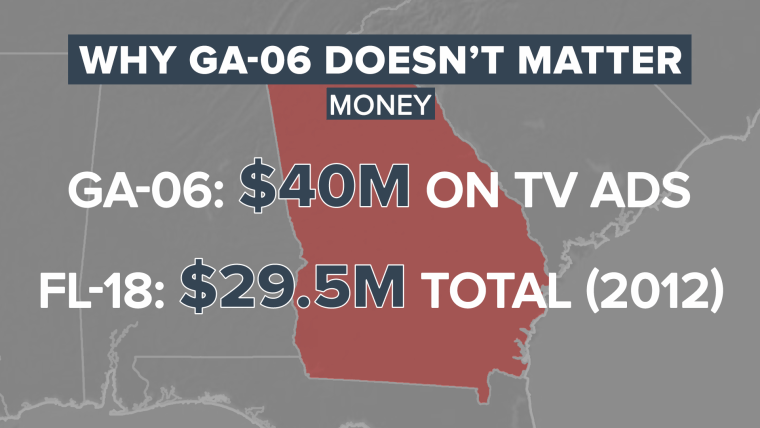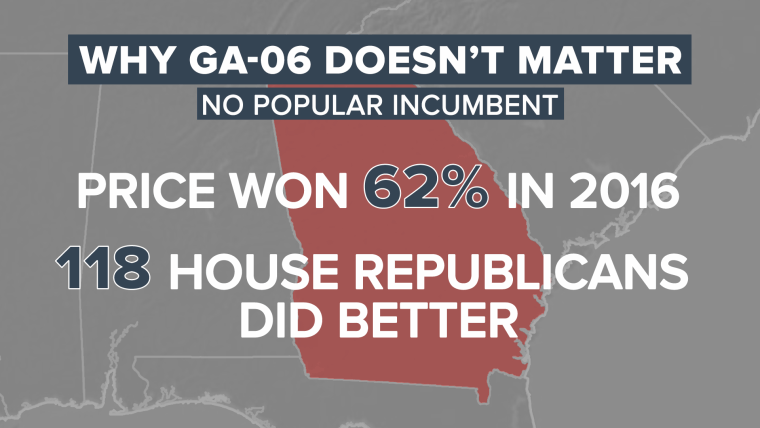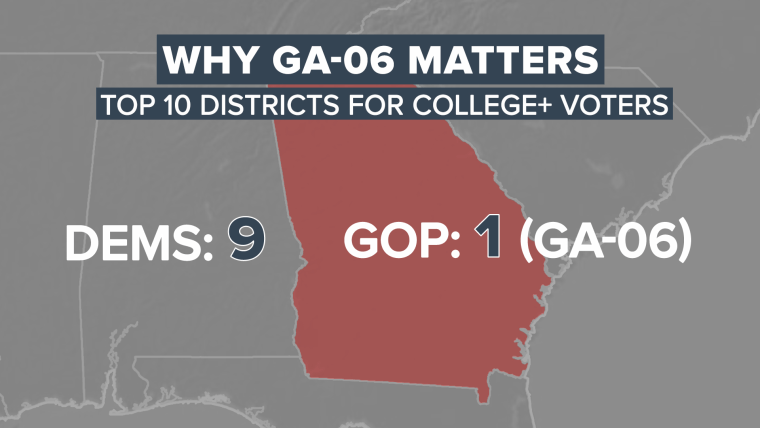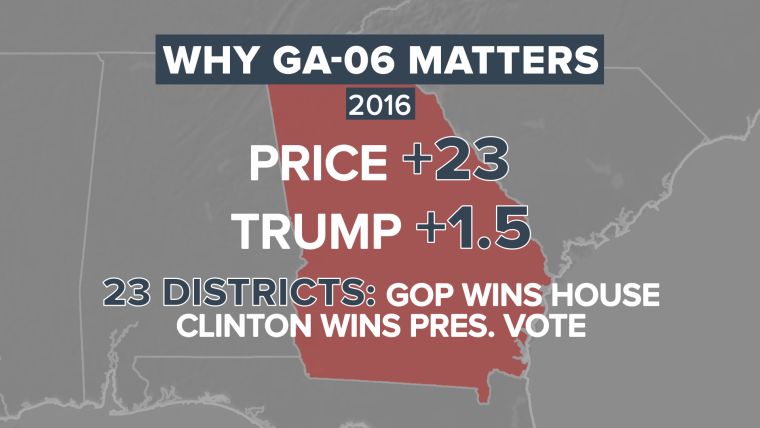As the hype has grown around Tuesday's special election in Georgia’s 6th congressional district, the contest has become the electoral equivalent of a summer blockbuster for political nerds. It’s got action, suspense and lots and lots of money.
But the real meaning of the race between Democrat Jon Ossoff and Republican Karen Handel is more complicated. Depending on how you look at it, the race could be an over-hyped outlier with little meaning for the 2018 midterms or an important indicator of what’s to come.
Here are the arguments for each of those viewpoints:
The Overhyped Sixth:
The money: For many political watchers the real eye-catching number in the district is “dollars spent” -- about $40 million on TV ads alone. To get a sense of how remarkable that is, consider that the most expensive House race in U.S. history was the election for Florida’s 18th district back in 2012, which rang in at $29.5 million total. That means there’s been $11 million more spent just on TV advertisingin this special election than in a regular House election in a presidential year.
But that’s actually an argument for why Tuesday’s race is an overhyped outlier. Will this kind of money be spent on a House race in 2018? That's extremely doubtful. When you’re the only game in town, money from around the country wants in on the action. There will be many more competitive races in 2018 and the money will be spread more thinly.

No popular incumbent: The district’s former representative, Tom Price, who left to become President Trump’s Health and Human Services Secretary, won this seat by more than 23 points last November. It wasn’t a real race with Price running against a nearly non-existent “ghost opponent,.”Still, 23 points is a more-than-solid margin of victory. Price is not on the ballot this time and an open seat presents a huge opportunity for the out-of-power party.
But in 2018, most seats will have incumbents people know and, presumably, like a bit. They elected them once after all. Price captured 62 percent of the vote in November when he won this seat. That may sound like a lot, but 118 Republicans in congress won with higher percentages and another 15 were unopposed. The vast majority of those GOP incumbents will be on the ballot in 2018.

Timing matters: Times are not good for President Donald Trump, and his performance is dominating all discussions of U.S. politics right now. He is under 40 percent approval in Gallup polling data and every day seems to bring a new revelation about investigations around the White House. The unsettled state of affairs has clearly worked to Ossoff’s advantage in the district. It may be enough to tip it to him.
But, as any good pollster will tell you, we are living through a particular moment in time regarding Trump. It could be that fall 2018 will look better for the president and his party. Maybe voters will have become accustomed to his very different approach to the presidency by then. Perhaps the White House investigations will come to a positive conclusion for him. Yes, it may seem hard to believe right now, but time, and events, can change attitudes.
The Sixth Matters:
The education story continues: As we noted recently on Meet The Press, college-educated voters are shifting away from the GOP. Demographically speaking, this race seems to offer a test of how strong that trend is and how quickly it¹s growing. Of the top 10 congressional districts for college-educated people, Georgia’s 6th is the only one a Republican won in the November. A win for Ossoff on Tuesday makes that a clean sweep of the top ten for Democrats.
And in 2017 there are signs the Democratic edge with college-educated voters is growing. There have been two special elections so far in 2017, Kansas¹s 4th district and Montana’s at-large seat. The Democrats lost both races, but the Democratic candidate won the counties with the highest percentage of college graduates in each, Sedgwick County in Kansas and Missoula, Gallatin, Lewis & Clark and Park in Montana.
The college education rate in Georgia’s 6th overall, 58 percent, is much higher than the figure for any of those counties. If Ossoff wins, a big part of the story will center on education and whether Trump is damaging the GOP brand among those with college degrees. If Handel wins, the Republicans can point to it as evidence that the president isn¹t hurting them as badly as some believe.

Clinton Republicans: Ultimately the vote on Tuesday is a test for what we might call “Clinton Republican” districts, where a Republican won the House seat but Donald Trump got a much smaller share of the vote. The 6th is a prime example of one of these. Trump eked out a win in the district (beating Clinton by 1.5 points), but Price won it going away (his margin was 23.4 points).
There are 23 districts where a Republican won the House seat, but Clinton won the presidential vote. If Ossoff wins it suggests Republicans in those seats have something real to worry about. GOP congresspeople such as Barbara Comstock in Virginia and Mike Coffman in Colorado may begin to distance themselves from Trump and that could make it much harder for the president to get things done in the House in the next year-and-a-half.
But if Handel wins, a lot of those concerns might dissipate. The Clinton Republicans in those 23 districts, and others where Trump did not perform especially well, might feel that standing with the president is in their best interest.

Whatever the results on Tuesday, there will be spin by both winners and losers, likely using one or more of these arguments. The biggest test in the results may be the margin.
By most accounts, the race looks very tight right now. If one candidate or the other wins comfortably, five points or more, the arguments behind “the Sixth matters” will look a lot more compelling.
